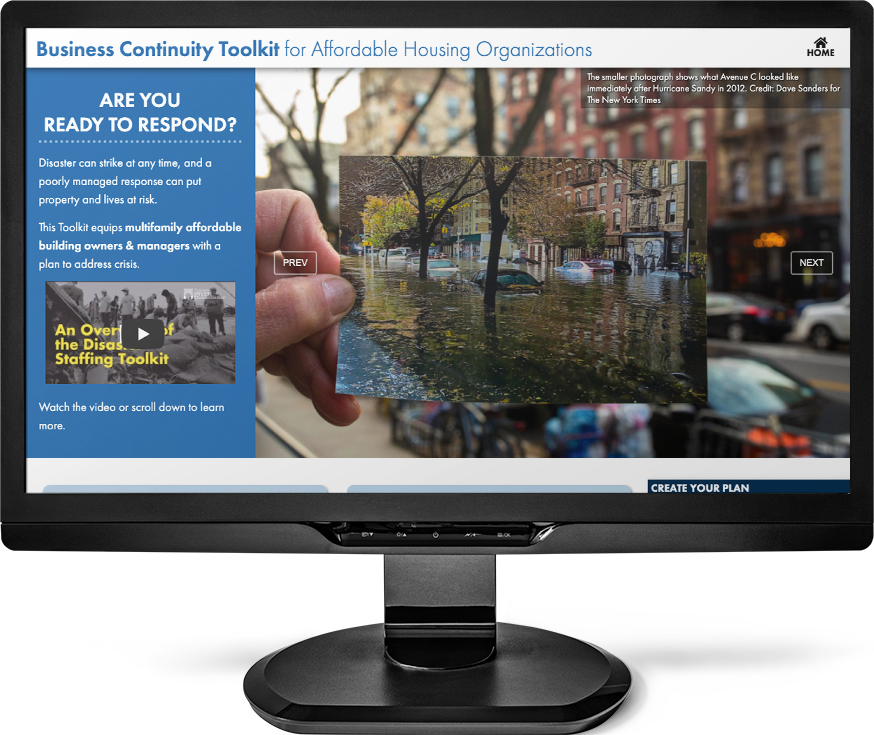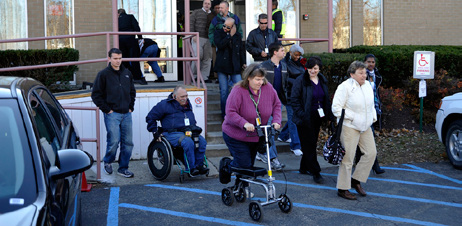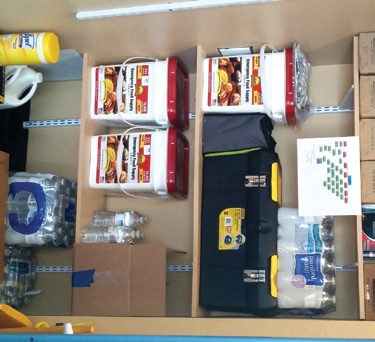Multi-Hazard Risk / Vulnerability
Assessment.
Description + function
An effective emergency plan prepares the entire organization for an emergency, promoting three core capabilities:
- Coordination. The organization works in a unified way across departments and with organizations and people outside.
- Communication. Staff and leadership communicate efficiently throughout a disaster.
- Information sharing. Vital updates reach staff, residents, leadership and outside people quickly.

Strategy into action
Analyze the hazards your buildings are vulnerable to. (See: Getting Started: Identify your hazard exposure, and Assess your risks).
Assign an emergency preparedness coordinator (EPC) to oversee the development of an emergency plan. The EPC will work with senior leadership to assign staff to emergency response roles, customize preparedness materials and tasks, coordinate trainings and implement revisions to the plan.
An emergency plan should consider:
| Task | Example |
|---|---|
|
Building protection. |
Equipment inventory and action plans, protecting IT and telecommunications infrastructure, shut-down and re-open protocols, managing vender relationships. |
|
Resident engagement. Support the safety, preparedness and recovery of residents. |
Emergency kits and go-bags, up-to-date information on residents, preparedness surveys, updated flyer templates, evacuation tracking sheets. |
|
Business continuity. |
Hard-copy record backups, insurance information, financial preparedness plan, staff work policies, emergency-related expense tracking sheets. |
Children, seniors, those with disabilities and other residents with special needs may need additional support, particularly during extreme heat or cold. Maintain detailed records about residents’ medications and medical or mobility equipment for residents who may need extra assistance in case of an emergency.
Operations + maintenance
Organizations should host training exercises to test their emergency plan and practice communication and coordination among staff members. Trainings attended by senior leadership, resident leaders and all staff involved in emergency planning should be held at least once a year.
Trainings may include a simulated emergency event, emphasizing the importance of emergency planning and allowing staff to practice their roles. The training facilitator should document training activities in a post-training report asking for feedback for what could be improved.

Estimated cost
- $
- $$
- $$$
- $$$$
Supporting strategies
Resources
- Emergency Action Plan Checklist, OSHA. www.osha.gov/SLTC/etools/evacuation/checklists/eap.html
- Enterprise Community Partners, Inc. Ready to Respond: Disaster Staffing Toolkit https://businesscontinuity.enterprisecommunity.org
- Incident Command System, Review Materials, FEMA. training.fema.gov/emiweb/is/icsresource/assets/reviewmaterials.pdf
Background
Bailey House is a supportive housing organization providing services for the homeless and people living with HIV/AIDS. Located in New York’s Greenwich Village at 180 Christopher St., the facility is in the AE flood zone within the 100-year floodplain.
The building had experienced flooding before, and had an evacuation procedure and emergency supplies in place. But the plan did not adequately prepare the Bailey House for Superstorm Sandy.
Strategy
After Sandy, Bailey House created an emergency plan based on the Incident Command System, a federally-recognized emergency management framework.
Bailey House divides its housing section into two areas. Facility Management combines resident engagement and building protection. Client Services maintains the social services Bailey House provides.
The emergency plan assigns roles to staff members and works on two levels, implementing disaster preparedness measures while setting up policies and procedures to be used during an actual disaster.
Cost
To create a custom-tailored emergency plan, Bailey House hired a private consultant at a fee of approximately $2,500.


